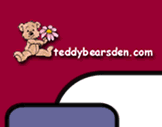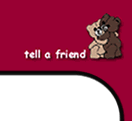|
TIPS FOR PINNING, STITCHING & TURNING
Tips & Hints | Bear Making Terms
| PIN, PIN, PIN, DO NOT SKIMP ON PINS ! |
- Place pieces to be sewn "right" sides together, tuck the fur between.
- Use long shank quilters pins to pin your work. Place the pins at right angles and use lots of them, sticking out as show on ear sample below.

- Leave a wide enough opening on the body parts that will be easy for the turning and jointing. Hand closing with the ladder stitch is a breeze!
-
To reduce the bulk for ears, try these tips:
| (a) |
for bears under 8", cut each ear in a circle (remove seam allowance from straight edge). Sew around edge and slit along the center of the folded edge to turn. Just remember to match the ears on the bear to be sure the fur is running in the right direction. |
| (b) |
for larger bears sew "around the corner" as shown above. Clip the corners off to get rid of the extra fabric. |
- Add 1/4" to the openings on the body parts for loosely woven fabrics tending to fray.
- If you plan to shave the muzzle, then consider removing the fur before stitching. This step will eliminate the "row of fur" or "rooster tailing" that can happen along a seam line.
- Use a 90/14 needle on your machine and a stitch size that is slightly smaller than normal. Double stitch along pressure points especially along nose, eye corners, bends of legs and arms.
- Double stitch every piece of every bear if using mohair. First one side, then turn over and stitch again. Even with careful pining there are slight imperfections you can correct the second go around.
- Double check paws and pads for smooth curves and that the sizes are matching. Consider drawing a stitching line before you pin to guide these critical stitches.
- Always, ALWAYS use a matching, closely coordinated machine sewing thread that is good quality. Avoid disappointment with threads breaking at the stuffing step. Use a balanced stitch and back stitch at the beginning and end of every seam.
-
Whichever way you stitch the gusset and head, consider the following:
| (a) |
Mark the center nose clearly. Fold gusset to find the true center. |
| (b) |
With a ruler, draw a line where the gusset changes. |
| (c) |
When pinning and stitching, be sure that "the line" ends up at the same spot on the side head pieces. Sometimes this line coincides with the place where the side head changes, sometimes not. The important thing is that the line is at the same place on each side head. |
-
Ways to handle sewing the gusset:
| (a) |
Method #1 "traditional method": Sew the seam from neck to nose (C-A), then set in gusset piece and stitch each half first from A to B, and then A to B2. Leave neck open.

|
| (b) |
Method #2: Sew seam from neck to nose (C-A. Then stitch gusset across nose portion A1 to A2. Ease in remainder of gusset then from A1 to B1 and A2 to B2.

|
| (c) |
Method #3: At the drawing out and cutting stage, square off the end of the gusset by extending parallel lines as shown

Fit the new squared end gusset to the side head pieces first A1 to B1 and then A2 to B2.

Pin the side head pieces together and push the gusset into the same (a pleat will form). Stitch from C to A. The result on finished ear forms a "triangle" which also helps with getting the nose in just the right spot.
|
|
HINT:
Since the head is so important it's okay to think about basting the head gusset in place before stitching!!
|
-
Pesky foot pads vs. Paw Pads Perfect?
Method #1: Use lots of pins to put foot pad in place as shown below. Stitch in place from the pad side being sure to get a nice rounded curve. OR stitch from the leg side - the assembly will "set up" because of the pins and allow you to get a nice smooth rounded curvy seam.
 |
Method #2:
- lay leg out flat
- snip a scant 1/4" into bottom of leg approximately 3/4" apart
- match heel on pad to center of leg and pin around
- snitch 1/2 of curve then other 1/2.
- close leg seam
 |
Method #3: Use lots of pins to ease foot pad into place as shown ((a) above). Stitch using backstitch being sure to get a nice rounded curve.
|
|
HINT:
When stitching the ends of curves, taper the seam rather than ending abruptly and ending up with a "squared off limb"
|
- Purchase a Teflon foot for your machine. This really helps your machine glide over the stickier materials such as ultra and leather on the paw and foot pads.
-
Curvy limbs will tend to torque - sew them twice - once each in opposite directions.
|
HINT:
This "reinforcing" makes it really easy to find the punched hot at the jointing step
|
-
After stitching, and before turning, reinforce the jointing holes as follows:
| (a) |
cut small 1/2" x 1/2" squares of ultra suede |
| (b) |
glue (use white craft glue) these squares directly over the joint mark |
| (c) |
push holes through with an awl. For arms and legs, hole on one side only. For body, you can push awl through both thicknesses at once. This also makes sure that legs and arms are attached evenly on both sides of the body |
- Sometimes it is desirable to make the teddy bear seam lines "disappear". To make the fur at the seams the same as the fur on the body, remove the trapped fur in the seam. You need to pick the fur before turning and again after the pieces are turned. The fur can be picked out of the seam with a needle or a bear brush.
-
TIME TO TURN:
| (a) |
with sharp scissors, snip tight curvy areas to the seam line. |
| (b) |
hemostats are very useful to turn pieces. Chopsticks or stuffing sticks also help get the pieces turned right side out. |
- Once pieces are turned right side out, you may wish to snip the fur around the holes very slightly so you can quickly locate joint holes.
|
PAW PADS
Any stable fabric can be used for paw and foot pads. Commonly used ones include felt, velour, soft leather, ultra suede and upholstery fabrics. If fraying is a concern, iron on a fusible interfacing.. This opens up the possibilities to include tartans, patterned silks, velvets, satins - just think of the possibilities that will make your bear even more special, perhaps one of a kind!
|
|
|












